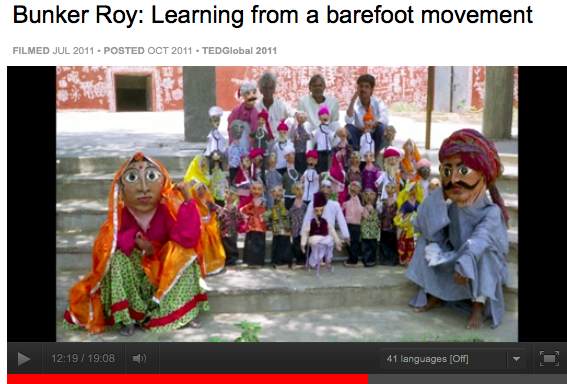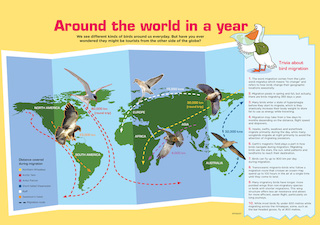www.youtube.com/user/barefootcollege >>

Address
BAREFOOT COLLEGE
Tilonia-305816, Via Madanganj
District Ajmer, Rajasthan, India
Source: Barefoot College | Contact Us
Address : http://www.barefootcollege.org/about/contact-us/
Date Visited: Sat Nov 09 2013 19:46:25 GMT+0100 (CET)
Barefoot College is a non-governmental organization that has been providing basic services and solutions to problems in rural communities for more than 40 years, with the objective of making them self-sufficient and sustainable. These ‘Barefoot solutions’ can be broadly categorized into the delivery of Solar Electrification, Clean Water, Education, Livelihood Development, and Activism. With a geographic focus on the Least Developed Countries (LDCs), we believe strongly in Empowering Women as agents of sustainable change.
Source: Barefoot College | home
Address : https://www.barefootcollege.org/
Date Visited: Sat Nov 09 2013 11:30:30 GMT+0100 (CET)
In Rajasthan, India, an extraordinary school teaches rural women and men — many of them illiterate — to become solar engineers, artisans, dentists and doctors in their own villages. It’s called the Barefoot College, and its founder, Bunker Roy, explains how it works.
Sanjit “Bunker” Roy is the founder of Barefoot College, which helps rural communities becomes self-sufficient.
Source: Bunker Roy: Learning from a barefoot movement | Video on TED.com
Address : https://www.ted.com/talks/bunker_roy.html
Date Visited: Sat Nov 09 2013 11:21:28 GMT+0100 (CET)

Library copies: Worldcat.org >>
Gandhian social movement >>
In a remote village on the scorched plains of Rajasthan, India, Barefoot College is at the heart of a stirring revolution. The college is one-of-a-kind: the only college “built by the poor, for the poor—and, for the last 40 years, managed, controlled, and owned by the poor”, as Founder Sanjit “Bunker” Roy explains. Here, grandmothers soak in training on solar engineering, puppetry is a preferred teaching method, there are no degree certificates, fees or exams, and formal qualifications are considered superfluous – indeed, in some cases, a disadvantage.
Despite rampant economic growth over the past decade, over 40% of India’s population—more than 496 million people—continue to live on less than $1.25 a day. Indeed, in 2010, India’s 100 richest individuals owned assets equivalent to one-quarter of the country’s GDP – stark evidence of the country’s yawning wealth gap. Consequent large-scale migration to cities has swamped India’s swelling slums, where an arguably harsher form of poverty awaits, and has also emptied villages of the youth upon whom a village’s potential for prosperity depends. Meanwhile, millions more villagers are being forced off their land to make way for ambitious construction projects – mines and dams that some view as gateways to progress.
While international NGOs have been working in rural India since colonial times, Bunker Roy argues that they, too, have been largely ineffective in improving the day-to-day lives of the country’s rural poor: “The approach that big donors and Western-conditioned experts have taken to reach the poor—forgetting about allowing the poor to develop themselves—has been patronizing, top-down, insensitive and expensive. It excludes the marginalized, the exploited and the very poor, and keeps them away from making decisions on their own.”
Formulating the ‘barefoot approach’ in the late-1960s—a time when both India’s government and NGOs were looking to technological and industrial development as means to end poverty—Bunker Roy took inspiration from the principles and teachings of one of India’s own: Mahatma Gandhi. “Gandhi believed that giving more importance, value and relevance to practical skills, and applying traditional knowledge to solving day-to-day problems were essential for the development of rural India,’ Roy says. “Gandhi’s thoughts live on in Barefoot College.”
Source: Barefoot College | Sosense
Address : http://impact.sosense.org/en/social-enterprise/68/updates
Date Visited: Sat Nov 09 2013 11:24:04 GMT+0100 (CET)
Up-to-date reports by Indian journalists and commentators
List of Indian magazines and web portals covered by the present Custom search engine
To search Indian periodicals, magazines, web portals and other sources safely, click here. To find an Indian PhD thesis on a particular tribal community, region and related issues, click here >>
Search tips
Combine the name of any particular state, language or region with that of any tribal (Adivasi) community.
Add keywords of special interest (health, nutrition endangered language, illegal mining, sacred grove); learn about the rights of Scheduled Tribes such as the “Forest Rights Act” (FRA); and the United Nations “Declaration on the Rights of Indigenous Peoples”, “Universal Declaration of Human Rights”, “women’s rights”, or “children’s right to education”.
Specify any other issue or news item you want to learn more about (biodiversity, bonded labour and human trafficking, climate change, ecology, economic development, ethnobotany, ethnomedicine, global warming, Himalayan tribe, hunter-gatherers in a particular region or state, prevention of rural poverty, water access).
For official figures include “scheduled tribe ST” along with a union state or region: e.g. “Chhattisgarh ST community”, “Scheduled tribe Tamil Nadu census”, “ST Kerala census”, “Particularly Vulnerable Tribal Group Jharkhand”, “PVTG Rajasthan”, “Adivasi ST Kerala”, “Adibasi ST West Bengal” etc.
In case the Google Custom Search window is not displayed here try the following: (1) toggle between “Reader” and regular viewing; (2) in your browser’s Security settings select “Enable JavaScript” | More tips >>
For additional learning resources visit the website of the Centre for Science and Environment (CSE), “a public interest research and advocacy organisation based in New Delhi”:
Communication for Awareness
CSE’s publications and informational products have been its strength and they have always combined research and readability to get the message across.

CSE’s tools for awareness raising are periodicals, publications, films/short spots, briefing papers, exhibitions, posters and other products. CSE’s informational products reach people in more diverse ways such as features service, website and e-news bulletins. […]
Source: About CSE
URL: https://www.cseindia.org
Date Visited: 10 July 2022
See also
Adivasi Academy & Museum of Adivasi Voice at Tejgadh | Lecture “A View of Higher Education in India”
Appropriate education for Adivasi children – the Vidyodaya School model at Gudalur
Childhood | Children’s books | Childrens rights: UNICEF India | Safe search
People’s Linguistic Survey of India | Volumes (PLSI) | PeoplesLinguisticSurvey.org
Multi-lingual education | Residential school | Ekalavya
Multilingual education is a pillar of intergenerational learning – Unesco
Santali education | Teaching Santal children by Boro Baski
Unesco | Unicef | Unicef India | United Nations
United Nations International Days and Weeks
Video | “Nations don’t make us human – languages make us human”: Ganesh Devy
Women | Safe search | President Droupadi Murmu on women’s empowerment